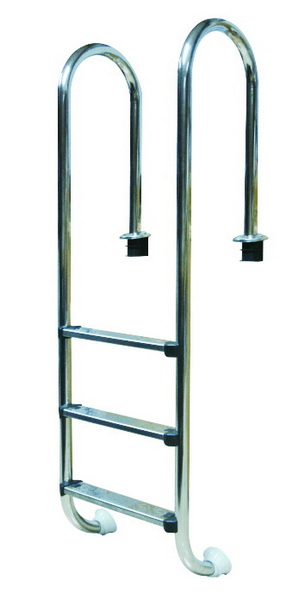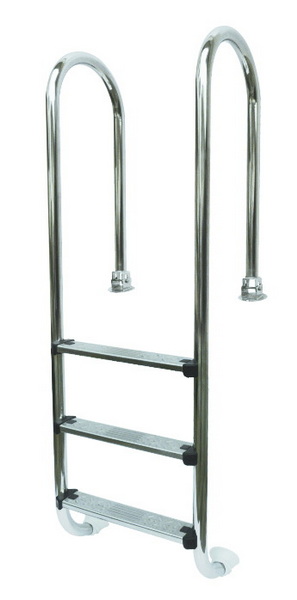Views: 222 Author: Tina Publish Time: 2025-09-16 Origin: Site








Content Menu
● Understanding Pool Ladder Anchors
● When and Why You Should Replace Anchors
● Tools and Materials Checklist
● Step-by-Step Anchor Removal Guide
>> Loosening and Extracting Old Anchors
>> Clearing Entrapped Concrete
>> Dealing With Difficult Cases
>> Cleaning Up and Preparing for New Installation
● Step-by-Step Anchor Installation Guide
>> Insert Anchor and Connect Bonding Wire
>> Secure Anchor With Epoxy or Cement
>> Final Ladder and Hardware Installation
● Pool Ladder Anchor Maintenance Tips
● Common Problems and Solutions
● Troubleshooting Advanced Repairs
>> 1. How do I know my pool ladder anchors need replacement?
>> 2. What's the best method to remove stuck anchors without damaging the deck?
>> 3. Can I install new anchors without redoing the concrete deck?
>> 4. Why is electrical bonding critical during anchor replacement?
>> 5. What if the ladder legs are deformed?
Pool ladder anchors are critical hardware for safe pool access, keeping ladders or rails stable for swimmers. Over time, corrosion, concrete shifting, or simple wear may require replacement of these anchors. This comprehensive guide explains each step—removal, installation, troubleshooting, and maintenance—with expert tips, industry advice, and rich visual and video references.[1][7][8]

Pool ladder anchors are usually manufactured from corrosion-resistant metals like stainless steel or bronze, and are securely installed into the pool deck. Anchor types include sleeve anchors, wedge anchors, and channel set anchors. These devices keep ladders and handrails locked in place, preventing wobbling and accident risks.[2][7]
The typical anchor setup features:
- Anchor cups: Recesses in concrete holding the ladder legs.
- Wedge bolts and brass wedges: Expand to grip the ladder rails tightly.
- Bonding wire connection: Ensures electrical safety.
Recognizing anchor failure or corrosion is essential:
- Ladder movement, instability, or looseness.[4]
- Severe rust, mineral deposits, or cement intrusion.
- Brass wedge or bolt failure; inability to tighten rails.
- Safety code upgrades requiring improved bonding.
Regular inspection helps prevent accidents and costly emergency repairs.
Removing and installing pool ladder anchors requires the following:
- Socket wrench set (preferably ½ inch drive)
- Hammer/rubber mallet
- Power chisel or concrete drill
- Angle grinder (for cutting rails if necessary)
- Shop vacuum and pipe cleaners
- Penetrating oil (WD-40)
- Masonry/concrete patching compound
- New anchors, brass wedges, stainless bolts
- Eye protection, gloves, dust mask
- Measuring tape and marker
1. Remove any decorative escutcheons to reveal the anchor hardware underneath.
2. Shine a flashlight inside anchor tubes to assess for rust, debris, or mineral buildup.
3. Liberally spray penetrating oil inside tube and onto bolts; allow 15–30 minutes for deep corrosion.
1. Use a socket wrench to turn anchor bolts counterclockwise, loosening the wedge mechanism.
2. Gently tap the bolt with a hammer to drive the wedge down inside the anchor, breaking its grip on the concrete.[7]
3. Grab ladder rails, rock back/forth, and pull up simultaneously. Stubborn anchors may require a mallet or even rail cutting with an angle grinder.
1. Frequently, over years, concrete or mineral buildup will constrict the anchor tube.
2. Use power chisel to carefully chip away blockages without enlarging anchor hole diameter or cracking the adjacent deck.[2]
3. If anchor body is severely corroded or deformed, insert a sturdy rod or channel locks for additional leverage to pull free.
Occasionally, anchors cannot be pulled out cleanly due to:
- Advanced corrosion causing anchor rupture.
- Concrete intrusion sealing anchor tube tight.
- Irreparable damage to anchor cup or deck.[4][7]
In these cases:
- Drill carefully around anchor, avoiding bonding wire.
- Remove ruined anchor and thoroughly patch hole with high-strength concrete.
- Allow patch to cure per compound manufacturer's instructions (usually 24–48 hours).
1. Vacuum all debris from holes.
2. Inspect condition of bonding wire if visible. Ensure it is not oxidized or broken—crucial for pool electrical safety compliance.
3. Patch any cracks or degraded concrete. Let cure fully before proceeding.[2]

1. Use measuring tape to pinpoint ideal anchor positions based on ladder dimensions, deck layout, and local safety codes.[3][2]
2. Mark center points and anchor hole diameters.
1. Masonry drill with appropriate bit (usually 4–5 inches diameter) is required for optimal anchor fitting.[2]
2. Core drill holes slightly deeper than anchor length for full insertion.
3. Shop vacuum and pipe cleaner clear away fine dust and allow for clean fit.
1. Slide anchor into drilled hole flush with the deck surface.
2. Orient wedge mechanism away from pool, per manufacturer's specs.
3. Attach anchor to rebar or copper bonding wire according to local code and the National Electrical Code (NEC), using approved connectors.[4][2]
1. Apply quality epoxy or high-strength compression-grade cement around the anchor (minimum 3,000 PSI recommended).[2]
2. Allow material to cure per manufacturer's instructions—most require 24–48 hours.
3. Ensure top of anchor is flush with finished deck for aesthetics and function.
1. Once anchors are set and cured, insert ladder rails deep into anchor tubes.
2. Tighten wedge bolts firmly to lock rails.
3. Replace escutcheons and decorative covers.
4. Test movement and ladder firmness; ladder should not wobble or shift under body weight.
- Annually inspect anchor hardware for corrosion, debris, and loose bolts.
- Lubricate bolts annually to prevent seizing.
- Clean anchor tubes' interiors with sandpaper or wire brush.[5]
- If ladder legs become hard to fit, check for tube deformation and consider repair plugs or professional adjustment.
Debris blocking ladder legs: Clean anchor tube and use wire brush to remove buildup.
Metal deformation: Use repair plugs to restore tube shape if ladder rails are not seating properly.[5]
"Metal expansion" myth: Corrosion and mineral deposits—not true metal expansion—can shrink effective tube diameter; clean thoroughly instead of cutting concrete.[5]
Missing anchors or bolts: Replace with matching anchor kits; surface-mount anchors offer easy installation but slightly less stability.[6][5]
Bonding wire issues: If wire is missing or damaged, engage a licensed electrician for compliant repair.[1][2]
For extremely old pools or cases with historic anchors (some dating to the 1940s), replacement may require extensive deck work and careful preservation of original wiring and structural elements.[5]
Surface-mounted anchors present a less invasive alternative if deck cutting is unacceptable, although they may not provide the strength of in-concrete units. It's crucial to maintain proper anchor spacing, level alignment, and secure bolt tension for every installation.[6]
- Always follow local building codes and manufacturer instructions, particularly regarding anchor placement, wire bonding, and deck patching compounds.
- Electrical bonding is mandatory to prevent electrical shock or corrosion, connecting all metallic parts of the pool system in a closed loop.[4][2]
- Proper curing of concrete patch before anchor use is essential for long-term deck stability.
Replacing pool ladder anchors is not just mechanical, but also a matter of safety compliance and durability. Diligent preparation, precise measurement, proper tool selection, and scrupulous attention to decking and electrical details ensure that every replacement is secure, long-lasting, and compliant with safety standards.
If replacement seems complicated or if bonding wires are inaccessible, consulting a pool professional or licensed electrician is advised.
Replacing pool ladder anchors is a meticulous process demanding careful planning, suitable tools, and compliance with local safety codes. From removing corroded hardware and patching deck concrete to measuring, drilling, and securely installing new anchors with bonded wires, each step contributes to a safe, robust pool environment. Follow the comprehensive steps outlined, always prioritize safety, and leverage expert video guidance. With proper technique, pool ladders will remain safe, functional, and compliant for years to come.[7][2][4][1]

Unstable movements, corrosion, and inability to lock bolts indicate a need for replacement.[7][5]
Use penetrating oil, correct tools, and gentle tapping. For severe cases, a power chisel and cautious drilling around the anchor may be needed.[7][4]
If anchor holes are only slightly damaged, cleaning and patching may suffice. For significant damage, new concrete may be necessary for safety.[4][5]
Bonding wires protect against electrical shock and accelerated metal corrosion; always reconnect or repair wires per code.[2][4][1]
Ladder repair plugs can reshape tubes; alternatively, replace with matching components or professional adjustment.[5]
[1](https://www.youtube.com/watch?v=cqGXFASqmak)
[2](https://www.srsmith.com/media/126979/rail-installation-guide-10_2017-lr.pdf)
[3](https://www.poolkingfilter.com/how-to-install-inground-pool-ladder-anchors.html)
[4](https://www.youtube.com/watch?v=tn-SqBQe26c)
[5](https://www.reddit.com/r/pools/comments/13ap2l4/advice_how_to_fix_ladder_mount/)
[6](https://www.poolwarehouse.com/shop/pool-ladder-or-rail-anchor/)
[7](https://www.poolkingfilter.com/how-to-remove-pool-ladder-anchors-in-concrete.html)
[8](https://www.youtube.com/watch?v=x9QfpHo-Kks)
[9](https://intheswim.com/c/ladder-and-handrail-parts/)
[10](https://mrpoolman.com.au/blogs/news/easily-install-or-replace-your-pool-ladders-and-rails)
